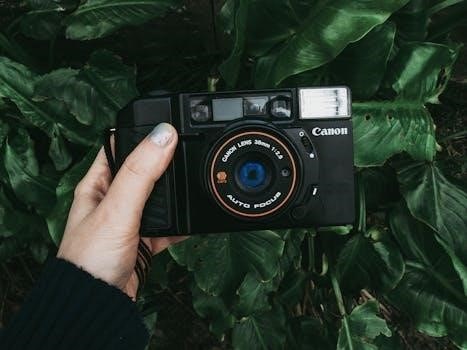The Canon EOS 350D, also known as the Digital Rebel XT, is a high-performance digital SLR camera. It’s designed for versatile and speedy shooting, suitable for both beginners and enthusiasts. The manual provides detailed instructions on camera functions, settings, and troubleshooting. It’s an invaluable resource for users seeking to maximize their photography experience.

Canon EOS 350D Specifications
The Canon EOS 350D boasts an 8-megapixel resolution, delivering clear and detailed photos. It includes a 1x digital zoom and a 1x optical zoom for versatile shooting options. The camera supports RAW and JPEG data compression, offering flexibility in image quality and file size. Its durable design ensures reliable performance.
Megapixel Count
The Canon EOS 350D features an approximate resolution of 8 megapixels, a specification that significantly impacts image quality and detail. This megapixel count allows for the capture of clear, detailed photographs suitable for various purposes, from casual snapshots to more serious photographic endeavors. The higher the megapixel count, the greater the level of detail that can be recorded in an image, enabling larger prints and more extensive cropping without significant loss of quality.
With 8 megapixels, the EOS 350D strikes a balance between image quality and file size, making it a practical choice for photographers who require both detail and manageable storage. This resolution allows for producing high-quality images with sufficient detail for printing, sharing online, and editing. The camera’s image processing capabilities work in tandem with the megapixel count to optimize image sharpness, color accuracy, and overall visual appeal.
The 8-megapixel sensor ensures that images retain a level of detail that meets the demands of most photography enthusiasts. Whether capturing landscapes, portraits, or everyday moments, the Canon EOS 350D provides the necessary resolution to produce stunning visuals. This megapixel count, combined with other features, contributes to the camera’s overall performance and versatility.
Zoom Capabilities (Digital and Optical)
The Canon EOS 350D incorporates both digital and optical zoom capabilities, offering users flexibility in capturing subjects at varying distances. The camera features a 1x digital zoom, which digitally enlarges the image, potentially sacrificing some image quality. Digital zoom essentially crops into the image and interpolates the pixels, which can lead to a loss of sharpness and detail compared to using optical zoom.
Complementing the digital zoom, the EOS 350D also includes a 1x optical zoom. Optical zoom uses the lens’s physical elements to magnify the subject, preserving image quality by not relying on digital interpolation. This results in clearer, more detailed images when zooming in on a subject. The optical zoom is particularly useful for capturing distant subjects without significant degradation in image quality.
The combination of digital and optical zoom provides users with options for framing their shots. While the digital zoom can extend the reach, the optical zoom is generally preferred for maintaining the highest possible image quality. Understanding the difference between these zoom types is crucial for photographers looking to maximize the capabilities of their Canon EOS 350D. The manual provides further guidance on utilizing these features effectively.
Image Data Compression (RAW/JPEG)
The Canon EOS 350D offers users a choice between two primary image data compression formats⁚ RAW and JPEG. Understanding the differences between these formats is crucial for optimizing image quality and workflow.
JPEG (Joint Photographic Experts Group) is a widely used format that compresses images to reduce file size. This compression involves discarding some image data, which can result in a loss of detail and potential artifacts. However, JPEG files are smaller and more manageable, making them suitable for everyday use and sharing.
RAW, on the other hand, is an uncompressed or minimally compressed format that retains all the data captured by the camera’s sensor. This provides maximum flexibility for post-processing, allowing users to adjust settings such as white balance, exposure, and contrast without significant quality loss. RAW files are larger than JPEGs but offer superior image quality and editing potential.
The Canon EOS 350D manual provides detailed instructions on selecting the appropriate image data compression format based on the photographer’s needs. It also offers guidance on post-processing RAW files using Canon’s Digital Photo Professional software or other compatible editing tools. Choosing between RAW and JPEG depends on the desired balance between image quality, file size, and post-processing requirements.

Included Items in the Box
The Canon EOS 350D box typically includes the camera body, a lens kit (often EF-S 18-55mm), a battery pack, and a charger. Accessories like eyecup, body cap, and software CD-ROM are also usually included. Check the contents against the provided checklist.
Camera Body and Accessories
The Canon EOS 350D camera body is the core component, featuring an 8-megapixel sensor for capturing detailed images. Included with the body are several essential accessories. The eyecup attaches to the viewfinder, providing a more comfortable and shielded viewing experience. The body cap protects the sensor when a lens is not mounted, preventing dust and damage. A lithium backup battery is pre-installed to maintain the date and time settings.
The camera’s design emphasizes ease of use, with intuitive controls and a user-friendly interface. Its durable construction ensures reliability for various shooting conditions. The grip is designed for comfortable handling, allowing for steady shots.
Additional accessories may include straps for convenient carrying and various connection cables for transferring images to a computer. The included software CD-ROM provides utilities for image management and editing. Always refer to the official Canon EOS 350D instruction manual for detailed information on handling and maintaining the camera body and its accessories to ensure optimal performance and longevity.
Lens Kit Contents
The Canon EOS 350D lens kit typically includes the EF-S 18-55mm f/3.5-5.6 II lens, a versatile option suitable for a wide range of photographic scenarios. This lens is designed specifically for cameras with an EF-S mount, offering excellent image quality and performance. The kit includes both a lens cap and a dust cap. The lens cap protects the front element of the lens from scratches and damage when not in use, while the dust cap safeguards the rear element and internal components when the lens is detached from the camera body.
The EF-S 18-55mm lens provides a useful zoom range, from wide-angle to standard, making it ideal for landscapes, portraits, and everyday photography. Its compact and lightweight design enhances portability, ensuring it’s easy to carry with the camera. The lens features Canon’s optical technology, delivering sharp and clear images. Always refer to the lens’s instruction manual for detailed information on proper usage and maintenance. Keep the lens caps in a safe place for future use.
Battery and Charger
The Canon EOS 350D typically comes with a dedicated Battery Pack NB-2LH, providing the necessary power for operation. This rechargeable lithium-ion battery is designed to offer a reliable and long-lasting power source for your camera. A protective cover is included with the battery pack to ensure its safety during storage and transportation, preventing any potential damage to the battery terminals.
The kit also includes a Battery Charger CB-2LT or CB-2LTE, specifically designed to recharge the NB-2LH battery. This charger ensures efficient and safe charging, optimizing the battery’s lifespan and performance. When using the charger, always follow the instructions provided in the manual to avoid any potential hazards or damage to the battery and charger. Fully charging the battery before its first use is recommended to maximize its capacity.
The battery and charger are essential components for keeping your Canon EOS 350D ready for use, ensuring you never miss those important photographic moments. Remember to store the battery in a cool, dry place when not in use.
Downloading the Canon 350D Manual
Accessing the Canon EOS 350D manual is a straightforward process, crucial for understanding your camera’s full potential. The manual is typically available as a PDF file, easily downloadable from Canon’s official support website or other reliable sources. To begin, navigate to the support section of the Canon website and search for the EOS 350D or Digital Rebel XT model.
Once you locate the correct product page, you’ll find a section dedicated to downloads, including drivers, software, and manuals. Click on the link for the instruction manual, which will usually prompt a download window. You can then choose to save the PDF file to your computer or open it directly in your browser.
Alternatively, various third-party websites also host the Canon EOS 350D manual for download. However, ensure you’re downloading from a reputable source to avoid any potential malware or corrupted files. Once downloaded, the manual can be easily accessed offline, providing a convenient reference guide whenever you need it.

Navigating the Instruction Manual
Effectively using the Canon EOS 350D instruction manual is essential for mastering your camera. The manual typically begins with a table of contents, providing a structured overview of the covered topics. Use this to quickly locate specific sections of interest, such as basic operations, shooting modes, or troubleshooting.
Pay attention to the manual’s layout, which often includes headings, subheadings, and visual aids like diagrams and illustrations. These elements help break down complex information into manageable chunks. For beginners, start with the introductory sections that explain the camera’s basic components and functions. Gradually move on to more advanced topics as your understanding grows.
Utilize the manual’s index to find specific keywords or features. If you’re unsure about a particular setting, look it up in the index, which will direct you to the relevant page. Don’t hesitate to refer back to the manual whenever you encounter difficulties or want to explore new features. Regular consultation will significantly enhance your photographic skills and overall enjoyment of the Canon EOS 350D.
Finding Software, Firmware, and Drivers
To ensure optimal performance of your Canon EOS 350D, it’s crucial to keep its software, firmware, and drivers up to date. The primary source for these resources is the official Canon website. Navigate to the support section, specifically searching for the EOS Digital Rebel XT or EOS 350D model.
Here, you’ll find a comprehensive list of available downloads, including software like Digital Photo Professional for image editing, firmware updates to improve camera functionality, and drivers that enable seamless communication between your camera and computer. Ensure you select the correct operating system (Windows or macOS) to download compatible files.
Before installing any updates, carefully read the instructions provided on the Canon website. Firmware updates, in particular, require a specific process to avoid damaging your camera. It’s also advisable to register your product on the Canon website to receive notifications about new software, firmware, and driver releases. Regularly checking for and installing these updates will enhance your camera’s capabilities and ensure its long-term reliability.

Troubleshooting Resources
Encountering issues with your Canon EOS 350D is not uncommon, and fortunately, ample troubleshooting resources are available to help you resolve them. Start by consulting the instruction manual, which contains a dedicated troubleshooting section addressing common problems such as error messages, image quality issues, or camera malfunctions.
The official Canon website also provides a wealth of support materials, including FAQs, knowledge base articles, and troubleshooting guides specific to the EOS 350D. These resources often cover topics like memory card compatibility, battery issues, and software-related problems.
For more complex issues, consider exploring online forums and communities dedicated to Canon cameras. These platforms allow you to connect with other EOS 350D users who may have encountered similar problems and can offer valuable insights and solutions.
If you’re unable to resolve the issue using these resources, contacting Canon’s customer support directly is recommended. They can provide personalized assistance and, if necessary, guide you through the repair process. Remember to have your camera’s serial number and a detailed description of the problem ready when seeking support.
